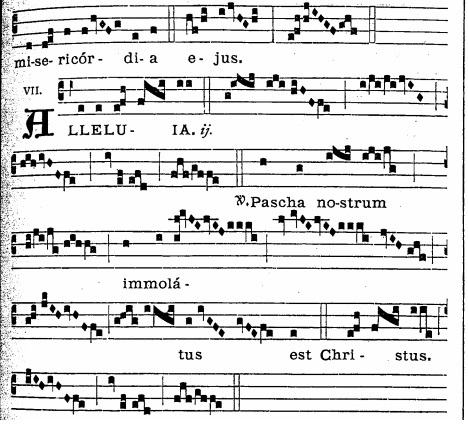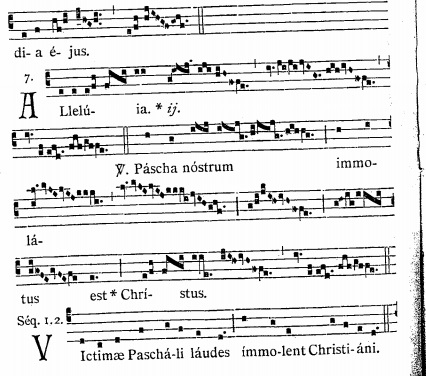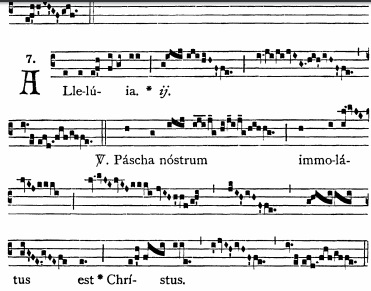Easter Alleluia
-
So, I'm just curious, and forgive me if this has already been covered in another thread...
How did we get from this (Dom Pothier, so.. Solesmes?) in 1883:
To this from Solesmes in 1903:
To this Solesmes version in 1962/"present":
?
 1883 Liber Gradualis Alleluia.jpg468 x 428 - 91K
1883 Liber Gradualis Alleluia.jpg468 x 428 - 91K
 1903 Liber Usualis.jpg426 x 376 - 76K
1903 Liber Usualis.jpg426 x 376 - 76K
 1961 Liber Usualis.jpg371 x 291 - 47K
1961 Liber Usualis.jpg371 x 291 - 47K -
I don't know. It's very interesting that all three editions share the same pitches in the same order, but the neume representations change, the rhythms are altered, and even quarter-bars are added (and moved).
If I had to guess, I'd propose that
- the 1883 version is closer to the "original," by which I mean the first source(s) consulted. Solesmes notation now includes several rhythmic indicators that they invented, and I've read that the most recent Solesmes editions will be (or perhaps already are) stripping away such markings. So the 1883 edition, without dots or episemas, may be a sort-of "urtext" approach, and perhaps in alignment with the most recent scholarship at Solesmes. (In other words, maybe a 2016 edition would look like the 1883...)
- the alterations in the later versions may have been introduced because Solesmes found additional manuscript sources with which they could compare/flesh out their melodic ideas, and/or they were developing a more comprehensive rhythmic system into which they retrofit the melodies they had already scored.
But to quote Monty Python, "this is my theory, which is mine..." I'm happy for the theory to be corrected by someone who has studied this more assiduously than I.Thanked by 1M. Jackson Osborn -
Daniel Saulnier is no longer at Solesmes, so we’ll see if future chant books do not include the rhythmic markings.
It is all based on the scholarship done by the monks. But the question is what were they trying to ultimately accomplish? An Ur-text is not necessarily ideal for liturgy... I suspect they found later editions which convinced them it needed to be more complex than in Pothier’s edition. -
I think it is because while Pothier was at Solesmes, he was transferred to another abbey in 1893, and his student Dom Moquereau was the one in charge of the 1903 Liber (see quote and linked article below). So a different guy in charge with ~20 years more research, but same abbey name/"brand".
The last version is the same as the 1908 vatican edition (besides the rhythm markings), which was led by Pothier, so it wasn't derived-from/based-on the Moquereau Liber.
Since the vatican edition was now the official version, the Solesmes/Moquereau Liber was changed to match. But since they were allowed to add markings, some of Moquereau's updated/different readings are perpetuated in the modern Liber anyways, for example the salicus marked in the first bar, despite being notated as a scandicus in the vatican edition.Much confusion exists with regard to whether the Catholic Church officially adopted the “Solesmes Edition” of the chant for the Vatican Edition. To understand the true state of things, one must realize that Dom Joseph Pothier entered the Solesmes congregation in 1859 and published his Liber Gradualis in 1883 along with several other important works on chant. In 1893 Dom Pothier was appointed Prior of Ligugé, a Solesmes daughterhouse. Then, in 1895, he became Abbot of St. Wandrille, another Solesmes daughterhouse. When Dom Pothier left Solesmes, his student Dom Mocquereau took over where he left off, and quickly started experimenting with different methods of publishing chant as well as modifying many of Pothier's ideas. It is enlightening to study these early Mocquereau editions and note the evolution of his notation, sometimes changing from month to month. As stated above, Dom Pothier used his editions as the basis for the Vatican Edition (especially the Graduale and Antiphonale). In this sense, one can say that the Vatican Edition was the “Solesmes chant,” because Pothier published his seminal works while at Solesmes.
-Jeff Ostrowski
-
It's just really interesting, because, though I hadn't seen the 1883 version til today, it's much closer to the way I sing when looking at the 1962 version.
And I've looked through some of the other older versions that are much further from what is above, which do have some manuscripts to back them up, but I was more interested in what is close to what other people are currently following to the T - with all the vertical episemas and significantly longated horizontal episemas.
Welcome to the MusicaSacra Forum!
To participate in the discussions on Catholic church music, sign in or register as a forum member, The forum is a project of the Church Music Association of America.
Categories
- All Discussions21,108
- General Music Discussion8,218
- Job Openings197
- Management of Music Programs850
- Choral Matters533
- Church Documents and Rubrics524
- CMAA Notes302
- Events716
- For Newcomers: Read First26
- Sacred Polyphony546
- Hymnody872
- Gregorian Chant: General2,698
- ↳ Graduale Romanum and Liber Usualis368
- ↳ Graduale Simplex60
- ↳ Semiology63
- Vernacular Plainsong696
- Anglican Use and Anglican Chant68
- Organ, Other Instruments and Repertoire435
- New Composition/Works in Progress1,291
- Recordings231
- Music for Hispanic Ministry159
- Music Education: Children211
- Music Education: General222
- News Items245
- Positions Wanted2
- General Discussion: Catholicism739
- Amusements177
- General Discussion1,033
- Opinions117

